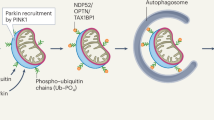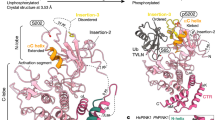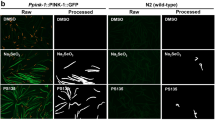Abstract
Mutations in the PINK1 gene cause autosomal recessive Parkinson's disease. The PINK1 gene encodes a protein kinase that is mitochondrially cleaved to generate two mature isoforms. In addition to its protective role against mitochondrial dysfunction and apoptosis, PINK1 is also known to regulate mitochondrial dynamics acting upstream of the PD-related protein Parkin. Recent data showed that mitochondrial Parkin promotes the autophagic degradation of dysfunctional mitochondria, and that stable PINK1 silencing may have an indirect role in mitophagy activation. Here we report a new interaction between PINK1 and Beclin1, a key pro-autophagic protein already implicated in the pathogenesis of Alzheimer's and Huntington's diseases. Both PINK1 N- and C-terminal are required for the interaction, suggesting that full-length PINK1, and not its cleaved isoforms, interacts with Beclin1. We also demonstrate that PINK1 significantly enhances basal and starvation-induced autophagy, which is reduced by knocking down Beclin1 expression or by inhibiting the Beclin1 partner Vps34. A mutant, PINK1W437X, interaction of which with Beclin1 is largely impaired, lacks the ability to enhance autophagy, whereas this is not observed for PINK1G309D, a mutant with defective kinase activity but unaltered ability to bind Beclin1. These findings identify a new function of PINK1 and further strengthen the link between autophagy and proteins implicated in the neurodegenerative process.
Similar content being viewed by others
Log in or create a free account to read this content
Gain free access to this article, as well as selected content from this journal and more on nature.com
or
Abbreviations
- 3MA:
-
3-methyladenine
- aa:
-
amino acid
- ER:
-
endoplasmic reticulum
- FL:
-
full length
- FLIM:
-
Fluorescence Lifetime Imaging Microscopy
- FRET:
-
Fluorescence Resonance Energy Transfer
- LC3:
-
Microtubule-associated protein light chain 3
- Mfn1:
-
Mitofusin 1
- MPTP:
-
1-methyl-4-phenyl-1,2,3, 6-tetrahydropyridine
- OMM:
-
outer mitochondrial membrane
- PD:
-
Parkinson's disease
- PI3K:
-
phosphatidylinositol 3′-kinase
- PINK1:
-
PTEN induced putative kinase 1
- TRAP1:
-
TNF receptor-associated protein 1
References
Gasser T . Mendelian forms of Parkinson's disease. Biochim Biophys Acta 2009; 1792: 587–596.
Valente EM, Abou-Sleiman PM, Caputo V, Muqit MM, Harvey K, Gispert S et al. Hereditary early-onset Parkinson's disease caused by mutations in PINK1. Science 2004; 304: 1158–1160.
Tan EK, Skipper LM . Pathogenic mutations in Parkinson disease. Hum Mutat 2007; 28: 641–653.
Petit A, Kawarai T, Paitel E, Sanjo N, Maj M, Scheid M et al. Wild-type PINK1 prevents basal and induced neuronal apoptosis, a protective effect abrogated by Parkinson disease-related mutations. J Biol Chem 2005; 280: 34025–34032.
Wang HL, Chou AH, Yeh TH, Li AH, Chen YL, Kuo YL et al. PINK1 mutants associated with recessive Parkinson's disease are defective in inhibiting mitochondrial release of cytochrome c. Neurobiol Dis 2007; 28: 216–226.
Wood-Kaczmar A, Gandhi S, Yao Z, Abramov AS, Miljan EA, Keen G et al. PINK1 is necessary for long term survival and mitochondrial function in human dopaminergic neurons. PLoS ONE 2008; 3: e2455.
Deng H, Jankovic J, Guo Y, Xie W, Le W . Small interfering RNA targeting the PINK1 induces apoptosis in dopaminergic cells SH-SY5Y. Biochem Biophys Res Commun 2005; 337: 1133–1138.
Sandebring A, Thomas KJ, Beilina A, van der BM, Cleland MM, Ahmad R et al. Mitochondrial alterations in PINK1 deficient cells are influenced by calcineurin-dependent dephosphorylation of dynamin-related protein 1. PLoS ONE 2009; 4: e5701.
Pridgeon JW, Olzmann JA, Chin LS, Li L . PINK1 protects against oxidative stress by phosphorylating mitochondrial chaperone TRAP1. PLoS Biol 2007; 5: e172.
Haque ME, Thomas KJ, D’Souza C, Callaghan S, Kitada T, Slack RS et al. Cytoplasmic Pink1 activity protects neurons from dopaminergic neurotoxin MPTP. Proc Natl Acad Sci USA 2008; 105: 1716–1721.
Lin W, Kang UJ . Characterization of PINK1 processing, stability, and subcellular localization. J Neurochem 2008; 106: 464–474.
Weihofen A, Ostaszewski B, Minami Y, Selkoe DJ . Pink1 Parkinson mutations, the Cdc37/Hsp90 chaperones and Parkin all influence the maturation or subcellular distribution of Pink1. Hum Mol Genet 2008; 17: 602–616.
Zhou C, Huang Y, Shao Y, May J, Prou D, Perier C et al. The kinase domain of mitochondrial PINK1 faces the cytoplasm. Proc Natl Acad Sci USA 2008; 105: 12022–12027.
Tan JM, Dawson TM . Parkin blushed by PINK1. Neuron 2006; 50: 527–529.
Exner N, Treske B, Paquet D, Holmstrom K, Schiesling C, Gispert S et al. Loss-of-function of human PINK1 results in mitochondrial pathology and can be rescued by parkin. J Neurosci 2007; 27: 12413–12418.
Yang Y, Ouyang Y, Yang L, Beal MF, McQuibban A, Vogel H et al. Pink1 regulates mitochondrial dynamics through interaction with the fission/fusion machinery. Proc Natl Acad Sci USA 2008; 105: 7070–7075.
Park J, Lee G, Chung J . The PINK1–Parkin pathway is involved in the regulation of mitochondrial remodeling process. Biochem Biophys Res Commun 2009; 378: 518–523.
Lutz AK, Exner N, Fett ME, Schlehe JS, Kloos K, Laemmermann K et al. Loss of parkin or PINK1 function increases DRP1-dependent mitochondrial fragmentation. J Biol Chem 2009; 284: 22938–22951.
Dagda RK, Cherra III SJ, Kulich SM, Tandon A, Park D, Chu CT . Loss of PINK1 function promotes mitophagy through effects on oxidative stress and mitochondrial fission. J Biol Chem 2009; 284: 13843–13855.
Narendra D, Tanaka A, Suen DF, Youle RJ . Parkin is recruited selectively to impaired mitochondria and promotes their autophagy. J Cell Biol 2008; 183: 795–803.
Kim I, Rodriguez-Enriquez S, Lemasters JJ . Selective degradation of mitochondria by mitophagy. Arch Biochem Biophys 2007; 462: 245–253.
Komatsu M, Ueno T, Waguri S, Uchiyama Y, Kominami E, Tanaka K . Constitutive autophagy: vital role in clearance of unfavorable proteins in neurons. Cell Death Differ 2007; 14: 887–894.
Martinez-Vicente M, Cuervo AM . Autophagy and neurodegeneration: when the cleaning crew goes on strike. Lancet Neurol 2007; 6: 352–361.
Winslow AR, Rubinsztein DC . Autophagy in neurodegeneration and development. Biochim Biophys Acta 2008; 1782: 723–729.
Gomes LC, Scorrano L . High levels of Fis1, a pro-fission mitochondrial protein, trigger autophagy. Biochim Biophys Acta 2008; 1777: 860–866.
Twig G, Hyde B, Shirihai OS . Mitochondrial fusion, fission and autophagy as a quality control axis: the bioenergetic view. Biochim Biophys Acta 2008; 1777: 1092–1097.
Weihofen A, Thomas KJ, Ostaszewski BL, Cookson MR, Selkoe DJ . Pink1 forms a multiprotein complex with Miro and Milton, linking Pink1 function to mitochondrial trafficking (dagger). Biochemistry 2009; 48: 2045–2052.
Silvestri L, Caputo V, Bellacchio E, Atorino L, Dallapiccola B, Valente EM et al. Mitochondrial import and enzymatic activity of PINK1 mutants associated to recessive Parkinsonism. Hum Mol Genet 2005; 14: 3477–3492.
Cao Y, Klionsky DJ . Physiological functions of Atg6/Beclin 1: a unique autophagy-related protein. Cell Res 2007; 17: 839–849.
Matsunaga K, Saitoh T, Tabata K, Omori H, Satoh T, Kurotori N et al. Two Beclin 1-binding proteins, Atg14L and Rubicon, reciprocally regulate autophagy at different stages. Nat Cell Biol 2009; 11: 385–396.
Gimenez-Xavier P, Francisco R, Santidrian AF, Gil J, Ambrosio S . Effects of dopamine on LC3-II activation as a marker of autophagy in a neuroblastoma cell model. Neurotoxicology 2009; 30: 658–665.
Mizushima N, Yoshimori T . How to interpret LC3 immunoblotting. Autophagy 2007; 3: 542–545.
Klionsky DJ, Cuervo AM, Seglen PO . Methods for monitoring autophagy from yeast to human. Autophagy 2007; 3: 181–206.
Cipolat S, Martins de BO, Dal ZB, Scorrano L . OPA1 requires mitofusin 1 to promote mitochondrial fusion. Proc Natl Acad Sci USA 2004; 101: 15927–15932.
Pattingre S, Tassa A, Qu X, Garuti R, Liang XH, Mizushima N et al. Bcl-2 antiapoptotic proteins inhibit Beclin 1-dependent autophagy. Cell 2005; 122: 927–939.
Pickford F, Masliah E, Britschgi M, Lucin K, Narasimhan R, Jaeger PA et al. The autophagy-related protein beclin 1 shows reduced expression in early Alzheimer disease and regulates amyloid beta accumulation in mice. J Clin Invest 2008; 118: 2190–2199.
Shibata M, Lu T, Furuya T, Degterev A, Mizushima N, Yoshimori T et al. Regulation of intracellular accumulation of mutant Huntingtin by Beclin 1. J Biol Chem 2006; 281: 14474–14485.
Maiuri MC, Criollo A, Tasdemir E, Vicencio JM, Tajeddine N, Hickman JA et al. BH3-only proteins and BH3 mimetics induce autophagy by competitively disrupting the interaction between Beclin 1 and Bcl-2/Bcl-X(L). Autophagy 2007; 3: 374–376.
Zalckvar E, Berissi H, Mizrachy L, Idelchuk Y, Koren I, Eisenstein M et al. DAP-kinase-mediated phosphorylation on the BH3 domain of beclin 1 promotes dissociation of beclin 1 from Bcl-X(L) and induction of autophagy. EMBO Rep 2009; 10: 285–292.
Petiot A, Ogier-Denis E, Blommaart EF, Meijer AJ, Codogno P . Distinct classes of phosphatidylinositol 3′-kinases are involved in signaling pathways that control macroautophagy in HT-29 cells. J Biol Chem 2000; 275: 992–998.
Nishida Y, Arakawa S, Fujitani K, Yamaguchi H, Mizuta T, Kanaseki T et al. Discovery of Atg5/Atg7-independent alternative macroautophagy. Nature 2009; 461: 654–658.
Chu CT, Zhu J, Dagda R . Beclin 1-independent pathway of damage-induced mitophagy and autophagic stress: implications for neurodegeneration and cell death. Autophagy 2007; 3: 663–666.
Semple JI, Prime G, Wallis LJ, Sanderson CM, Markie D . Two-hybrid reporter vectors for gap repair cloning. Biotechniques 2005; 38: 927–934.
Hallworth R, Currall B, Nichols MG, Wu X, Zuo J . Studying inner ear protein–protein interactions using FRET and FLIM. Brain Res 2006; 1091: 122–131.
Acknowledgements
We are grateful to Dr. Sylvia Lombardo for technical support, Dr. Alessandro Ferraris for statistical analysis support, Prof. David Markie for help in designing the yeast two-hybrid experiment and for providing the pGBD-B vector, Dr. Francesca De Marchi for providing GFP–LC3 (pEGFPC1-LC3) and Prof. Luca Scorrano for providing human Mitofusin1 (pCB6Myc-MFN1) and human WT DRP1 (pcDNA3.1-DRP1) plasmids. This study was supported with grants from Telethon Foundation (GGP07210 to EMV and GC), Italian Ministry of Health (Ricerca Corrente 2008–2009, Ricerca Finalizzata 2004 and 2006 and ex art.56 to BD) and Fondazione Cariplo (to GC). The support of Fondazione Livio Patrizi and Transgenomics is also gratefully acknowledged. The sponsors had no role in study design, data collection and analysis, decision to publish or preparation of the paper.
Author information
Authors and Affiliations
Corresponding authors
Ethics declarations
Competing interests
The authors declare no conflict of interest.
Additional information
Edited by M Piacentini
Supplementary Information accompanies the paper on Cell Death and Differentiation website
Supplementary information
Rights and permissions
About this article
Cite this article
Michiorri, S., Gelmetti, V., Giarda, E. et al. The Parkinson-associated protein PINK1 interacts with Beclin1 and promotes autophagy. Cell Death Differ 17, 962–974 (2010). https://doi.org/10.1038/cdd.2009.200
Received:
Revised:
Accepted:
Published:
Issue date:
DOI: https://doi.org/10.1038/cdd.2009.200
Keywords
This article is cited by
-
The human OPA1delTTAG mutation induces adult onset and progressive auditory neuropathy in mice
Cellular and Molecular Life Sciences (2024)
-
Galantamine Inhibits Aβ1–42-Induced Neurotoxicity by Enhancing α7nAChR Expression as a Cargo Carrier for LC3 Binding and Aβ1–42 Engulfment During Autophagic Degradation
Neurotherapeutics (2020)
-
Mitophagy-driven metabolic switch reprograms stem cell fate
Cellular and Molecular Life Sciences (2019)
-
SESN2 facilitates mitophagy by helping Parkin translocation through ULK1 mediated Beclin1 phosphorylation
Scientific Reports (2018)
-
Hyperactivated mitophagy in hematopoietic stem cells
Nature Immunology (2018)



